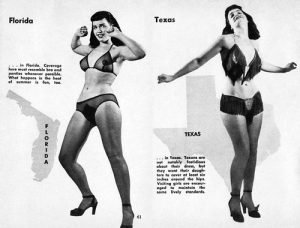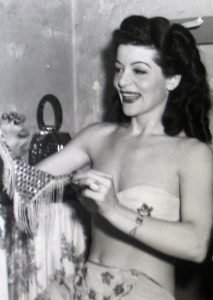As a burlesque performer or even an enthusiast you may have seen the old photos of Bettie Page in the “Guide for Strip-Teasers.” It was published in 1953 as a guide to show how much a stripper could reveal depending on what US. State she was in. Burlesque has changed a lot since 1953, most especially the underwear! Let’s take a journey through the ages from the beginnings of burlesque onwards, as a whole, to see how the last few layers of a showgirls costume have changed. One key area of debate is over whether the underwear worn in burlesque performances has kept getting smaller over time. In everyday life, underwear has come a long way and gotten smaller but trends in performance underwear don’t always follow trends in the “real world.” No matter what state or country you perform in, let’s see what is underneath when a stripper takes it off! Burlesque started out a lot more unclothed then what we see today. Performers were known to reveal their bare breasts onstage and sometimes even more. Josephine Baker, a dancer that was a cabaret hit in the 1920s, was known for dancing topless onstage in just her famous banana skirt. Pasties and g-strings didn’t become the burlesque norm until the early 1930s when New York City Mayor, Fiorello LaGuardia began to crack down on burlesque. Despite the law changing everywhere, some performers still revealed more then the law allowed by having “flaps” on the front of their g-string which with a graceful hand and a bump in the hip would give the audience a quick peek at what was underneath!
One thing that has decreased over time is not the underwear itself but the amount of layers of underwear. In the Golden Era of burlesque, a showgirls underwear would consist of an outer bra, an under bra that was triangular and netted(and sometimes adorned with tassels) and then pasties. Then came, what burlesque legend Sherry Britton referred to as the “piece de resistance” — the g-string. Performers would have an outer g-string and then an inner g-string. All these layers would be removed one by one, teasing the audience. How did they get through all those layers of underwear? Like today, they used snaps and hooks and eyes on their undergarments to remove them as easily as possible. In the late 1950s, Velcro was introduced to the world. Although slightly more noisy, this would mean garments could be removed faster and more easy. As go-go dancing became more popular in the 1960s, so did go-go dancing costumes. This was when many burlesque performers lost their layers of undies.

Bra and panty set worn by Kiva in the 1970s, on display at Documenta(13) in 2012 (from BHoF collection; photo by Nils Klinger)
But as time went on not only did underwear of burlesque performers evolve so did the go-go dancer. Go-go dancers were originally performance dancers in night clubs(sometimes dancing from inside cages), however in the ‘70s some go-go dancers lost their tops leading the way to the “modern day” fully nude stripper. As you can imagine, as a burlesque performer who doesn’t go fully nude, it can be hard to compete and try to change when business begins to reveal all. This also meant that many costumiers of the time lost work. According to Gussie Gross*, a well-known costume designer to many a burlesque star, “When burlesque went topless, I lost half of my business, and when it went bottomless it put me out of business.”
Modern burlesque has taken a different turn. With no act ideas nowadays being really 100% original, many performers go for new and unique costumes and of course shock value in order to stand out on stage. Now not everyone chooses this option when creating costume for a new act, barely there merkins and c-strings guarantee shock value and minimal, very much acceptable coverage. In the “real world” the age old merkin made a come back via the motion picture industry in 1960s America. This was so that female actors could appear “naked” on film, while covering their genitalia with a merkin and the film could still secure an acceptable cinema rating instead of going straight to video. The c-string on the other hand is a modern underwear invention simply designed to prevent panty lines when worn with clothes and to prevent tan lines when worn without.
But who wore the first merkin in a burlesque performance? Who decided to decorate a c-string and reveal it on stage? That is not known for certain but both appear to be prominent on the modern burlesque stage being worn by Dirty Martini, Michelle L’Amour, and Lada Redstar. Anna Fur Laxis, famously ends more then one of her acts with a merkin or a c-string complete with “butt jewel” as well as The Stage Boy Johnnies who love to show off and be creative with the male equivalent!
What does the future of underwear behold? Will the layers return to bring back more of the traditional retro tease of the Golden Era? A burlesque showgirl’s underwear has not necessarily gotten smaller as the size tends to vary due to trends and shock appeal but will we see more daring burlesque performers baring merkins and c-strings? Showgirls rhinestoned panties may stay the same or even test their limits further. One thing is for certain, if they do get any smaller or even non-existent burlesque will have gone back to its original roots and what is wrong with that? If it was good enough for Josephine Baker, it could be good enough for future burlesque starlets! Don’t get your knickers in a twist ladies and gents, I’m sure you will find out soon enough on a stage near you! * Read more about Gussie Gross and see some of the costumes she made in the fabulous book Pretty Things.



